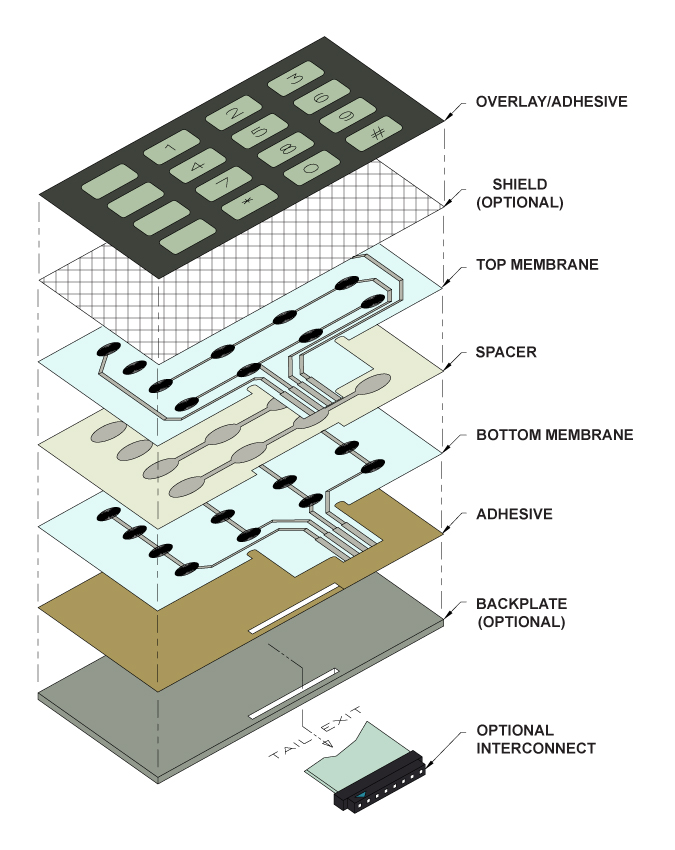Membrane Layer Switch Over Modern Technology: The Secret to Reliable and Cost-Effective Interfaces
Membrane layer button technology has actually emerged as a crucial element in the design of individual interfaces, offering both integrity and cost-effectiveness across a varied variety of applications. As we explore the diverse benefits of membrane buttons, their capacity for innovation increases questions concerning future applications and developing fads.
Understanding Membrane Layer Switch Innovation
Membrane switch modern technology is a commonly made use of interface option in various electronic tools, providing a smooth mix of performance and layout. This modern technology integrates numerous layers of materials, typically containing a graphic overlay, spacer layer, and a circuit layer. The graphic overlay displays the user interface aspects, while the spacer layer separates the circuit layer from the overlay until a customer turns on a button.
When stress is put on the overlay, the circuit layer finishes the electric circuit, sending a signal to the tool. This device enables various configurations, consisting of tactile responses and backlighting choices, improving customer interaction. Membrane buttons are normally manufactured utilizing durable materials such as polyester or polycarbonate, ensuring longevity and resistance to ecological variables like wetness and dirt.
The adaptability of membrane layer switches enables their application in varied sectors, consisting of medical devices, consumer electronics, and industrial controls. Their compact design enables assimilation right into space-constrained settings, giving a reliable customer interface without endangering visual allure. Recognizing the details of membrane layer button innovation is crucial for suppliers and developers looking for to produce reputable and efficient human-machine interfaces.
Key Advantages of Membrane Layer Buttons
While different interface solutions exist, membrane layer switches over offer unique benefits that make them a recommended selection in many applications. One of the primary advantages is their durability; membrane layer switches are developed to withstand rough ecological conditions, consisting of dampness, dust, and temperature variations, guaranteeing lasting efficiency. This durability significantly reduces the demand for constant replacements, thereby reducing total maintenance costs.

Additionally, membrane buttons are light-weight and compact, making them suitable for applications where area is restricted. Their inconspicuous layout adds to a sleek appearance without jeopardizing capability.
Cost-effectiveness is also a noteworthy advantage, as the manufacturing process for membrane layer changes often tends to be more economical contrasted to traditional mechanical switches. This affordability, combined with their reliability and ease of setup, settings membrane changes as a useful service for a wide variety of markets seeking effective and effective interface.
Applications Across Various Industries
Exactly how do membrane switches adjust to the diverse demands of different markets? Membrane button technology is significantly acknowledged for its versatility, making it ideal for a broad range of applications throughout several sectors.
In consumer electronics, membrane layer switches give a compact service for remotes and home devices, enhancing individual experience via user-friendly design. Furthermore, the commercial field leverages membrane layer buttons for machinery control board, profiting from their resistance to severe settings, such as moisture and dust.
Army and aerospace applications additionally use membrane look at this now layer buttons for their integrity and capacity to withstand extreme conditions, ensuring functional efficiency in vital scenarios. The food and beverage market takes on these switches for automated systems, where cleanliness and simplicity of procedure are critical (membrane switch). Eventually, membrane switches are tailored to meet the one-of-a-kind needs of each market, showing their vital role in contemporary technology interfaces
Style and Customization Options

In the realm of membrane layer switch technology, design and modification alternatives play a crucial function in enhancing capability and individual interaction. These switches can be customized to fulfill details operational requirements and visual preferences, making them functional components in numerous applications.
One of the key personalization options is the layout of the button internet itself, which can be created to accommodate one-of-a-kind interface and ergonomic considerations. By readjusting the form, size, and arrangement of switches, producers can develop intuitive layouts that facilitate simplicity of use. Additionally, the unification of various colors and graphic overlays enables branding and improved presence, making certain that users can rapidly recognize functions.
Additionally, membrane layer switches can be crafted with numerous tactile responses mechanisms, such as raised switches or distinct clicks, to boost the user experience. Various products can also be selected for durability and environmental resistance, addressing factors such as dampness, temperature changes, and chemical exposure.
Eventually, the substantial layout and customization choices offered in membrane layer button modern technology empower companies to produce customized remedies that not just fulfill functional demands yet likewise straighten with their branding and functional demands.

Future Trends in Membrane Layer Buttons
As membrane button technology remains to develop, future fads are progressively concentrated on enhancing individual experience and incorporating advanced functionalities. One substantial pattern is the assimilation of touch-sensitive and capacitive innovations right into typical membrane layer buttons. This advancement permits even more instinctive interface, giving responsive responses while keeping a streamlined style.
One more arising fad is the use of environmentally friendly products, driven by the expanding demand for sustainable manufacturing techniques. Suppliers are looking for to minimize their carbon footprint by utilizing recyclable substratums and low-impact inks, straightening with international sustainability objectives.
Additionally, the increase of the Internet of Points (IoT) is motivating the incorporation of smart functions into membrane buttons. Improved connectivity options will certainly make it possible for devices to connect with each various other, enabling seamless assimilation right into broader systems.
In addition, innovations in printing modern technologies, such as click now digital printing, are enabling higher design adaptability and modification. This makes it possible for makers to produce intricate designs and vivid colors cost-effectively.

Final Thought
In verdict, membrane layer switch innovation represents an essential technology in customer interface design, providing considerable benefits in durability, personalization, and cost-effectiveness. As developments proceed to arise, specifically in touch-sensitive interfaces and sustainable materials, the possibility for membrane layer switches to enhance individual experience and performance continues to be encouraging.